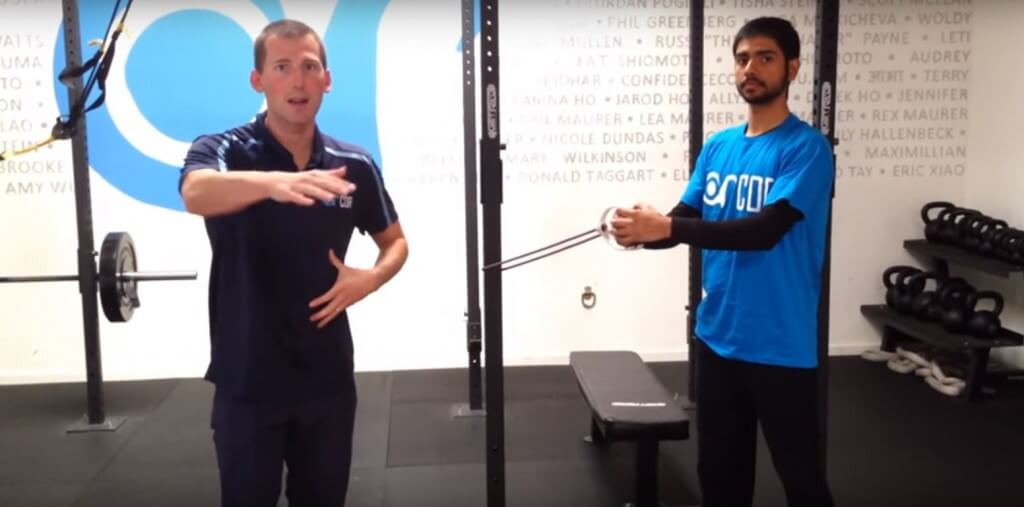New Year Resolution: Improved Swimming Core Strength

By Dr. G. John Mullen, DPT, CSCS
I’ve written many articles about sexy, challenging swimming core strength training exercises:
I’ve also posted many videos on the topics…
Elite Swimming Core Strength Exercises:
In fact, at COR we do some highly complicated core exercises for our professional athletes. Unfortunately, many swimmers fall for the sexy and fall for the 3 Core Training Mistakes That Swimmers Make.
Many swimmers (and everyday people) want to skip the basics and hit the hard stuff. What we don’t usually like to learn are the basics, when these are arguably the most important.
For core training, there is debate regarding core activation. Many physical therapists and strength coaches teach the abdominal-drawing in method (ADIM). I disproved this method in my Swimming Core Training digital book, as the abdominal-drawing in method minimally activates the core and does not create core stability. This motion is theoretically believed to increase core stability by recruiting the transverse abdominus (TA), a commonly weak muscle in those recovering from low back pain. In the past, the ADIM method has been repeatedly shown to not increase spinal stability (Vera-Garcia 2007). More interestingly, recent research suggests the ADIM method also doesn’t increase the contraction of the beloved TA (Grooms 2012).
I do not advocate the abdominal-drawing in method for core activation, instead I prefer abdominal bracing. To teach swimmers how to activate their core, I have them perform abdominal bracing on their back.
Many swimmers (elite and age-group) cannot activate their core! If you are having problems with this, consider finding a personal trainer and learn how to contract your core! If you are a big-time swimmer or already have a six-pack, ensure you can contract your core. I’ve worked with too many swimmers and kids with six-packs who could perform endless sit-ups, but couldn’t activate their core– just because you have a six-pack, doesn’t mean you’re strong!
Bracing and Marching
Contracting your core via bracing is step one. Once you master bracing, it is time to see if you can do while your legs (particularly your hip flexors) move. The march is a simple, yet challenging, core exercise.
During this exercise, you must follow the core rules:
- Maintain the bracing position.
- Do not let that position change AT ALL during the exercise.
- Stop if the exercise causes any pain.
- Stop if you cannot keep the correct back position.
For the march:
- Bring one knee to chest.
- Hold it there.
- Then bring the other knee to the chest.
- Let one leg down, then the other.
- Repeat.
Many will skip over this, assuming they have a strong core. Unfortunately, many have an extremely weak core, even with their six-pack abs.
Can you perform bracing? Can you march? Can you breathe during the march? If so, let us know in the comments!
- McGill SM, Karpowicz A.Exercises for spine stabilization: motion/motor patterns, stability progressions, and clinical technique. Arch Phys Med Rehabil. 2009 Jan;90(1):118-26.
- Grooms DR, Grindstaff TL, Croy T, Hart JM, Saliba SA. Clinimetric Analysis of Pressure Biofeedback and Transversus Abdominis Function in Individuals With Stabilization Classification Low Back Pain. J Orthop Sports Phys Ther. 2012 Nov 16. [Epub ahead of print]
- Vera-Garcia FJ, Elvira JL, Brown SH, McGill SM. Effects of abdominal stabilization maneuvers on the control of spine motion and stability against sudden trunk perturbations.J Electromyogr Kinesiol. 2007 Oct;17(5):556-67. Epub 2006 Sep 22.




Grace Gutier Angela Fong
Interested in this Adam?
Grace Nordquist
In Lehman’s terms, Gary Mullen is a BOSS. Just sayin…
As an aside, this article is phenomenal. Not unlike the rest of his work. Enjoy!
haha, thanks for the kinds words! Boss Mode!
Elie Hajjar
John Gatfield